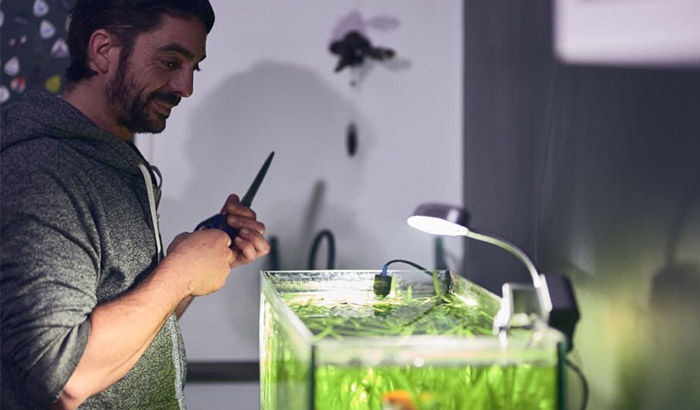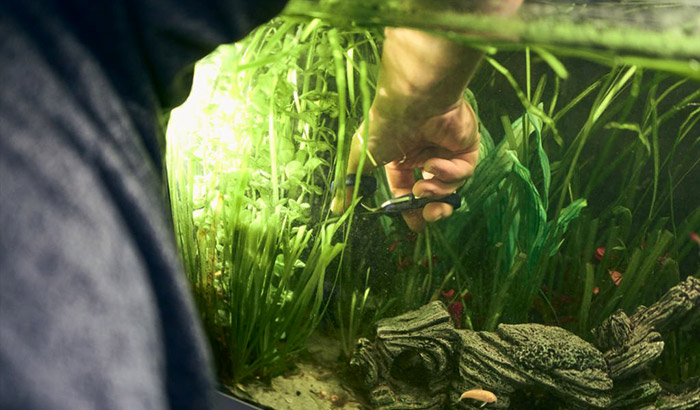There are many benefits to having live plants in your aquarium. Aquarium plants enhance water quality, prevent algae growth, and produce oxygen that the fish will use. However, when the plant grows and starts to fill out the aquarium, trimming is essential to these plants.
But how to trim aquarium plants? The growth rate of aquarium plants is different from that of regular plants. Small but frequent trimming is preferable when trimming aquarium plants. Here is the step-by-step guide below:
What to Prepare:
- Wavy Scissor
- Aquarium Fish Net
Step 1: Preparation
The initial step is to prepare all the materials you need for the trimming. Prepare the wavy scissor which will be used to trim the plants. The fish net will be used to clean and remove all the parts of the plants that will be cut. Some of them will be used to be replanted in your aquarium.
Then, you can turn on the filter and the heater before the trimming starts. You can also unload some water from the fish tank to prevent any spillage. It will also be better to remove the glasswork of the aquarium if there is any.
Step 2: Trimming Different Types of Aquarium Plants
When learning how to prune aquarium plants, you need to be familiar with doing different types of trimming to various aquarium plants. There are many types of aquarium plants that require different ways of trimming.
When trimming stem plants, you will need to regularly cut the longest shoots, which are located above one of the bottom leaves. From there, new shoots will come out from the cut stems after some time.
The bottom layer and the moss will be trimmed similar to a lawn. The trimming should be done backwards to achieve the plants’ fast growth. But there are also other aquarium plants which should be trimmed differently compared to others. Please see the list below:
Rhizome Plants
Rhizome plants are aquarium plants which have strong rootstocks. An example of rhizome plants is the Java ferns which come with thick green shoots called the rhizome. The rhizome is an essential part of the plant and should be protected during the trimming.
The rhizome plants’ roots and leaves can be trimmed or clipped using a scissor once the plants are too thick inside the aquarium. The rhizome stem can be trimmed between a bunch of leaves when the plant is too big in the fish tank. New shoots will grow in the leaf base of the plant.
Rosette Plants
Rosette plants such as crypts and echinodorus are similar to rhizome plants in terms of structure. The plant stem of the rosette plants is a rootstock called a rhizome. The only difference is that the rhizome of these plants is more compressed and grows below or above the surface.
If you want to trim rosette plants, you must be fully aware of the plant’s structure. If you want to re-plant, you can cut off longer roots just near the rhizome while leaving enough length for the roots to provide grip on the surface.
Also, these plants are trimmed by removing the outer leaves of the rosette. You can also remove the leaves that cast shadows over the surface.
Ground Cover Plants
Ground cover plants are usually composed of individual plants that grow within each other. Planting ground cover plants is better by dividing them into smaller portions before planting. These plants have the tendency to be too high or too wide.
When trimming ground cover plants, it is advised to trim them regularly with scissors. You will need to cut the upper shoots and reduce them a few centimeters above the ground. After cutting, you need to siphon out all the parts that have been cut off.
Mosses
When trimming moss, it is a must to turn off the filter while siphoning the cut parts using a hose. If you do not turn off the filter, the small parts will be carried by the current and possibly grow in another place in the aquarium.
Trimming more is relatively easier since any tiny snippet of moss can actually grow fast. You can trim the moss using scissors. You can also divide it by plucking small patches using your bare hands.
Stoloniferous Plants
Stoloniferous plants usually propagate through stolons. It will start from a stalk where the side shoot is formed. The side shoot grows away from the plant as new roots and leaves develop while creating a whole new plant.
When it comes to trimming stoloniferous plants, you will need to cut the leaves when they are too long or old already. You will only need to cut the leaves using a pair of scissors at any given point. The remaining part of the plants will just die eventually.
Please note that stolons are also trimmed when they are invading the other plants in the fish tank. The oldest plants can be replaced with other stolons from time to time.
Step 3: Replanting of Aquarium Plants
After trimming your plants, you can have the option to replant those parts that have been cut. It is called plant propagation, where the trimmed parts will be used to add plants to your fish tank. Replanting can be done after trimming the stem plants of your aquarium.
You will need to remove the stem leaves before putting them into the fish tank substrate. Plant as many as you like as long as there is still space in the fish tank. Expect it to grow a few weeks after replanting.
Conclusion
If you want to learn how to trim aquarium plants, you must be familiar with the different plants inside your aquarium. Each of these plants requires other trimming techniques depending on their type. When the trimming is correctly done, expect the plants inside your aquarium to grow and bring substantial benefits to the fish and the aquarium.


